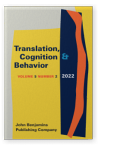Vol. 5:2 (2022) ► pp.187–215
Translation of allusive literary text in both directions
The cognitive efforts and influencing factors through eye-tracking technology
The translation of culture-specific expressions has received considerable attention in translation studies in recent decades; however, the translation of allusion and allusive text has rarely been touched upon. This article reports an eye-tracking study which aims to answer the following question: What factors influence the allocation of cognitive efforts (CE) in L1 and L2 translation of allusive text? Results from a generalised linear mixed model revealed that for the 30 Chinese student translators who participated in this study, the impact of allusion type was significant in L1 but not L2 translation. Allusion familiarity, the source context length and typing speed have no significant relationship with the amount of CE in all areas of interest (AOIs). Meanwhile, Skopoi and the visits to the external resources correlated with the CE in both directions of the translation process.
Article outline
- 1.Introduction
- 2.Debates on Directionality
- 3.Translation of Allusion
- 4.Methodology
- 4.1Participants
- 4.2The experiment design
- 4.3Source text selection
- 4.4The Eye-tracker and Interface
- 4.5AOIs and Eye-tracking metrics
- 4.6Eye-data quality
- 4.7Data analysis model
- 5.Findings: Variables affecting ST + TT AOI in L1 and L2 translation
- 5.1Significant Variables for the ST+TT AOI in both directions
- Skopos type
- Visits to External resources
- 5.2Significant Variables for the ST+TT AOI in L1 translation
- Allusion type
- Paragraph length
- 5.3Non-significant Variables for the ST+TT AOI in the translation process: Experience type, Allusion Familiarity and Typing speed
- 5.1Significant Variables for the ST+TT AOI in both directions
- 6.Conclusion
- Notes
-
References
